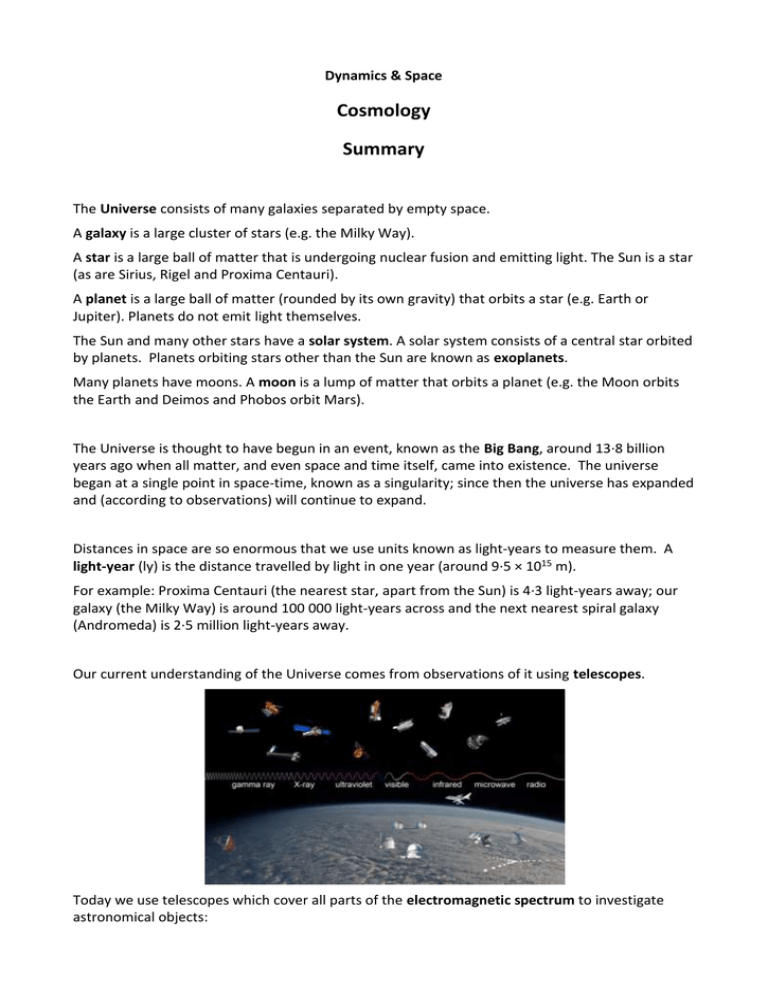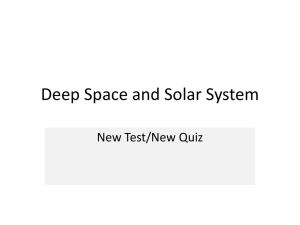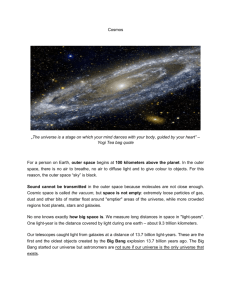Cosmology - Glow Blogs
advertisement

Dynamics & Space Cosmology Summary The Universe consists of many galaxies separated by empty space. A galaxy is a large cluster of stars (e.g. the Milky Way). A star is a large ball of matter that is undergoing nuclear fusion and emitting light. The Sun is a star (as are Sirius, Rigel and Proxima Centauri). A planet is a large ball of matter (rounded by its own gravity) that orbits a star (e.g. Earth or Jupiter). Planets do not emit light themselves. The Sun and many other stars have a solar system. A solar system consists of a central star orbited by planets. Planets orbiting stars other than the Sun are known as exoplanets. Many planets have moons. A moon is a lump of matter that orbits a planet (e.g. the Moon orbits the Earth and Deimos and Phobos orbit Mars). The Universe is thought to have begun in an event, known as the Big Bang, around 13·8 billion years ago when all matter, and even space and time itself, came into existence. The universe began at a single point in space-time, known as a singularity; since then the universe has expanded and (according to observations) will continue to expand. Distances in space are so enormous that we use units known as light-years to measure them. A light-year (ly) is the distance travelled by light in one year (around 9·5 × 1015 m). For example: Proxima Centauri (the nearest star, apart from the Sun) is 4·3 light-years away; our galaxy (the Milky Way) is around 100 000 light-years across and the next nearest spiral galaxy (Andromeda) is 2·5 million light-years away. Our current understanding of the Universe comes from observations of it using telescopes. Today we use telescopes which cover all parts of the electromagnetic spectrum to investigate astronomical objects: e.g. Part of Spectrum Examples of telescopes radio Arecibo Joddrell Bank Very Large Array (VLA) discovery of pulsars and quasars studying plasma clouds studying the Sun’s magnetic field microwaves Holmdel Horn Antenna Cosmic Background Explorer (COBE) the existence of cosmic microwave background radiation – evidence of the Big Bang infrared Spitzer Herschel visible light Hooker Kepler Very Large Telescope (VLT) Hubble Space Telescope observations of galactic redshift – evidence of the expanding Universe imaging planets, stars and galaxies ultraviolet Galaxy Evolution Explorer (GALEX) studying star formation measurement of distances to distant galaxies X-rays Solar and Heliospheric Observatory (SOHO) Chandra studying the Sun’s atmosphere studying supernovae Fermi evidence of supermassive black holes at centres of galaxies studying gamma ray bursts – probably due to hypernovae gamma rays Observations made studying nebulae, gas clouds and the formation of stars identification of exoplanets One of the techniques used in astronomy is spectroscopy A complete (continuous) spectrum is made up of all the colours of the spectrum (red, orange, yellow, green, blue, indigo and violet). A line spectrum consists of a complete (continuous) spectrum with certain colours missing which appear as black line in the spectrum. Every element produces a unique line spectrum. Studying line spectra allows the elements present in a light source (e.g. a star) to be identified. This can allow the type, distance, age or speed of a star to be identified.









